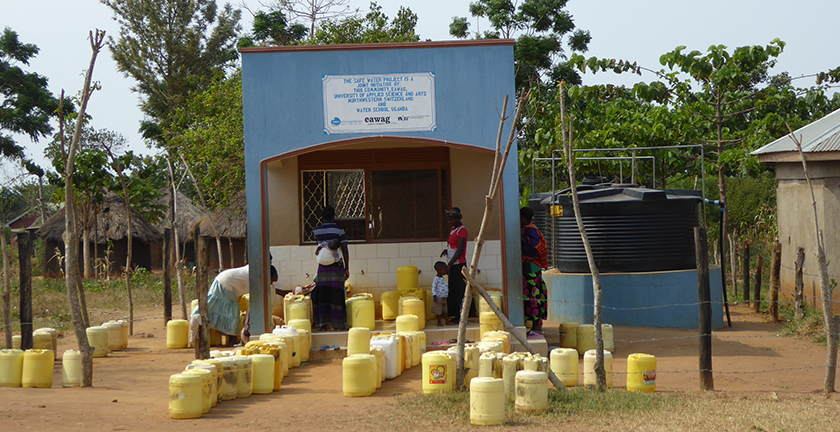Department Sanitation, Water and Solid Waste for Development
Gravity Driven Membrane Filtration (GDM)

Gravity-driven membrane (GDM) filtration is a water treatment method that uses the gravity pressure of water and ultrafiltration membranes with a pore size of 20-40nm. When biofilm is allowed to form on the membrane over time, water flux stabilizes at 4-10 litres per hour per square meter of membrane and filters do not clog. Very little maintenance is required to operate GDM systems. Project evaluations revealed that systems are very durable and can be operated over years only requiring a monthly backflush. Filters remove all classes of pathogenic microorganisms including viruses, bacteria and protozoa.
Due to their ease of operation and independence of external inputs such as replacement parts, chemicals or electricity, community scale systems of GDM can be installed in remote areas and can be managed by local communities. Alternatively, GDM household filters provide water treatment to individual users.
More information about research on gravity driven membrane filtration at Eawag
In March 2017, Eawag and FHNW received the Swiss Prize for Sustainable Development, the prix eco.ch for the GDM activities with the project Gravit'eau.
Gravity Driven Membrane Filtration in Water Kiosks in Uganda

Since June 2014, five water kiosks were established in Busime, Bulwande, Lugala, Bumeru and Bulundira in Busia and Namayingo Districts of Uganda to evaluate the feasibility of Gravity Driven Membrane filtration for drinking water treatment at community scale. Each system treats up to 6000L of water per day from Lake Victoria, providing treated water to local schools and the surrounding community.
Water from Lake Victoria is pumped up to the treatments systems at the school using a solar pump. Membrane modules are placed in a first tank where water is filtered and flows driven by gravity to the safe water storage tank. The treated water is available for the community at the taps of a water kiosk. Project evaluation revealed that the GDM systems are very robust, can be operated with little maintenance over years also in very remote rural contexts and that they provide reliable water quality.
Water quality assessments at the household level however revealed that water is being recontaminated during transport and storage due to critical hygienic conditions. We are therefore experimenting with different approaches to reduce recontamination risks such as providing residual disinfection via installing passive in-line chlorination at the water treatment system und using improved, cleaned water containers for transport and storage.
Elements that contribute to sustainable operation of the water kiosks include: An enabling environment, adequate management and business planning, accountability in financial handling, low cost for operation and maintenance, ownership and demand from the community, sufficient capacity for maintaining and repairing the systems, support from the Government’s extension services and supply chains for spare parts. In a case study, we described and analysed the business and management model of the GDM kiosks and how it evolved over time.
Publications
Project Reports and Documents
Gravity Driven Membrane Filtration for Household Systems

A first design of a GDM system for drinking water treatment at household level was developed 2011 after an extensive evaluation of the technology in the laboratory. 24 α-protoypes were evaluated in households in Kenya to assess the performance, functionality of the filter in the context of a low-income country and evaluate acceptance and user-friendliness.
In collaboration with ZHdK, Zurich University of Arts a β-prototype was developed in 2013 taking into consideration insights from the field evaluation of the α-protoype. These β-prototype were produced and evaluated in Bolivia to assess performance, handling and acceptance of users and willingness to pay for such products.
Project results of gravity driven membrane filtration for household water treatment
